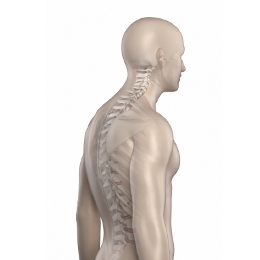Kyphosis is a medical condition of a curvature of the upper spine which is signified by an exaggerated rounding of more than 40-50 degrees. Here we would discuss the basic symptoms of kyphosis.

Kyphosis may also be defined as a forward rounding of the vertebrae in your thoracic spine. People with this problem may have a normal looking spine or they may develop a hump. Mild cases of kyphosis may not give rise to severe problems, however, cases which are too grave may cause complications in the lungs, nerves, other tissues and organs of the body.
Factors Behind Kyphosis
Kyphosis of spine are of different types and depending on these types, the causes vary. One type is known as the postural kyphosis. This condition is more common in girls and may be caused due to a poor posture and slouching. The other type, which is more common in boys, is what is known as Scheuermann's kyphosis. It becomes apparent between ages 10 - 15. What causes this condition, remains unknown and far from being identified. However, it is for certain that this condition, also known as Scheuermann's disease, has a tendency to run in families. Then comes congenital kyphosis. This is a manifestation of a malformation of the spinal column, which may occur during fetal development. This type of kyphosis is known to worsen as the affected child grows to become an adult. One severe and possible complication which might result from this condition is paralysis of the lower half of the body. In adults, the same condition may be caused by osteoporosis, cancer or benign tumors on spine bones, spina bifida, tuberculosis, Marfan syndrome or other connective tissue disorders, ankylosing spondylitis and conditions that cause paralysis.
What Indicates Kyphosis?
If the condition is of a mild nature, then there are as such no noticeable symptoms. But severe cases are indicated by the affected person developing a slouching posture or a hunch back. The patient may begin to feel his spine becoming stiff or undergoing tenderness. In addition to all these, the patient may also suffer from back pain which can be mild or severe and he may suffer from back pain with movement. A forward posture of the head is also one characteristic sign of kyphosis, and so is a difference in shoulder height. Other than these, chest pain, tight hamstrings (one of the tendons at the back of the knee), breathing difficulty and fatigue are the other symptoms which can accompany the condition of a rounded back. However, in some people, the neck (cervical spine) may also develop a kyphotic curve, i.e., an outward curve. So in this case, the symptoms might include limited neck movements, neck pain, weakness in arms or legs, difficulty walking, loss of grip strength, low bowel control and paralysis. As a whole, the symptoms will be similar in both the cases of kyphosis.
Treatment of kyphosis treatment depends on the nature of its symptoms. Cases which are mild and require less aggressive treatment include exercises, pain relievers, anti-inflammatory medication, physical therapy and managing the underlying causes. More severe cases where the symptoms show no signs of improvement and keep getting worse, may require the act of bracing and sometimes surgery, as the last option. These two methods help in curbing the progress of the deformity.
To conclude, apart from the right treatment, patients must have caring people to turn to. This physical illness is something which affects adolescents more than adults. So, helping them cope and fight with their condition, provides great deal of motivation and help in the treatment.


 Kyphosis may also be defined as a forward rounding of the vertebrae in your thoracic spine. People with this problem may have a normal looking spine or they may develop a hump. Mild cases of kyphosis may not give rise to severe problems, however, cases which are too grave may cause complications in the lungs, nerves, other tissues and organs of the body.
Kyphosis may also be defined as a forward rounding of the vertebrae in your thoracic spine. People with this problem may have a normal looking spine or they may develop a hump. Mild cases of kyphosis may not give rise to severe problems, however, cases which are too grave may cause complications in the lungs, nerves, other tissues and organs of the body.